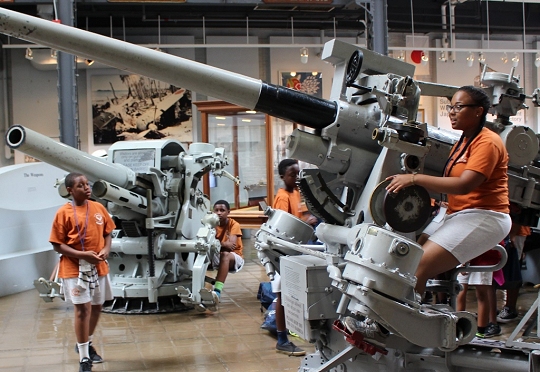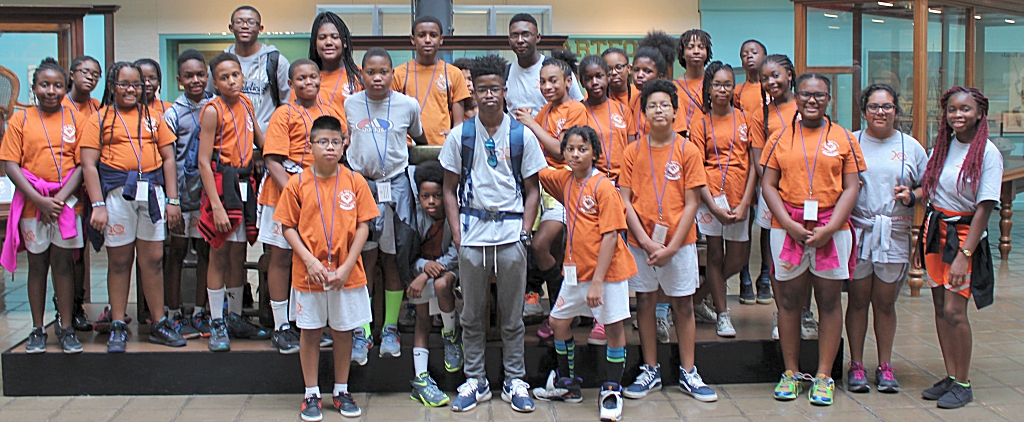 Middle and high school students from Camp Dogwood Summer Academy get a Navy gunner's perspective on 40mm anti-air guns at the National Museum of the United States Navy, July 12. Retired Navy officers joined scientists and engineers from Naval Surface Warfare Center Dahlgren Division and a museum official to brief 29 students from the academy on submarines and exhibits ranging from a diving capsule and torpedo room to a periscope and artic undersea operations, including ice breakthroughs. (U.S. Navy photo by Brittany Noah/Released)
Middle and high school students from Camp Dogwood Summer Academy get a Navy gunner's perspective on 40mm anti-air guns at the National Museum of the United States Navy, July 12. Retired Navy officers joined scientists and engineers from Naval Surface Warfare Center Dahlgren Division and a museum official to brief 29 students from the academy on submarines and exhibits ranging from a diving capsule and torpedo room to a periscope and artic undersea operations, including ice breakthroughs. (U.S. Navy photo by Brittany Noah/Released)WASHINGTON (July 29, 2016)—The deep-diving research vessel that took two hydronauts to the deepest point of the world's oceans 56 years ago is still diving—in many ways, deeper than ever.
The Trieste—a Swiss-designed, Italian-built bathyscaphe acquired by the U.S. Navy in 1958—first made history by reaching the bottom of the Challenger Deep in the Pacific Ocean's Marianas Trench on Jan. 23, 1960.
U.S. Navy Lt. Don Walsh and scientist Jacques Piccard traveled nearly seven miles—precisely 35,797 feet—aboard the Trieste to prove that humans could safely explore the deepest ocean depths.
Now, the Trieste is making history with deep dives into the dreams and imaginations of students visiting the Undersea Exploration exhibit at the National Museum of the United States Navy.
"I really loved getting into the submarine that went into the deepest part of the ocean," said Tre, 11, who was briefed on the Trieste and its achievement—the equivalent of putting a man on the moon.
Tre was among 29 middle and high school students from Camp Dogwood Summer Academy visiting the museum with their scientist and engineer mentors from Naval Surface Warfare Center Dahlgren Division (NSWCDD), July 12.
"This camp is a great opportunity for students to learn more about all of STEM (science, technology, engineering and mathematics) opportunities within the Navy," said Brittany Noah, an NSWCDD human factors engineer. "It's also a great way for the Navy to pique the interest of bright minds for active duty and civilian service in the future."
Retired Navy officers Richard Bryant and Rodney Luck piqued students' minds with presentations that included the science behind how a submarine submerges, dives, and rises to surface.
"I learned about buoyancy and how a submarine operates," said Jasmine, 12.
"Being able to interact with all the exhibits really caught my imagination and showed us what things were like a long time ago, and how they are now," added Amir, 12. "I really want to design a future sub. My favorite activity was being on the guns."
Amir, Jasmine, Tre and their peers also learned about navigation, fire control, torpedoes, propulsion plant, and sonar.
"The highlight of the tour was when we were able to move the big guns around," said Brianna, 12. "I would love to join the Navy after I do sports. I learned about how many people fit in different types of submarines and how they have improved over the years."
What's more, Bryant and Luck shared sea stories about operational aspects of submarine life, explaining how the crew ate, sleep, trained, and enjoyed morale activities like pizza night, movie night, and Xbox challenges.
"My favorite part was when we learned about the submarines and how many people can fit in them," said Delonte, 11.
The students were briefed at exhibits ranging from a diving capsule, torpedo room, and periscope to 40mm anti-air guns and artic undersea operations, including ice breakthroughs.
"I loved when we saw the submarine jump out of the water," said Tre. "I thought it was really cool."
The museum's Undersea Exploration Exhibit highlights the U.S. Navy's involvement with undersea exploration for navigation, scientific research, strategic, and educational purposes. By 1958, the Navy—often a catalyst for innovative research—funded nearly 90 percent of all U.S. oceanographic ventures. It enabled scientists to explore the deepest regions of the oceans and to design increasingly sophisticated remotely operated vehicles that could observe the depths without risk to human life.
"The students saw how submarines have been with the U.S. since the start of our nation and that we are still innovating submarines today," said David Barker, the museum's deputy director of education and public programs. "They loved the story about the Trieste and how deep it went."
Improvement of naval operations and equipment continues to be largely dependent on the discoveries made through oceanographic research. The Navy's undersea operations have ranged from diving to the collection of scientific data, to the investigation of shipwrecks such as the Titanic.
Camp Dogwood Summer Academy is one of many programs sponsored by the AnBryce Foundation philanthropic organization to promote social change by building a community of global citizens through education, career, cultural, and leadership opportunities to under-resourced young people.
The academy offers distinct summer experiences for young people ages 7-18: Camp Dogwood for rising 2nd through 9th graders; Rites of Passage for rising 10th through 12th graders, and the Staff Training Enrichment Program for rising 11th and 12th graders. For over a decade, the ratio of one counselor for two campers ensures individualized mentoring and instruction. At the end of every session, each camper is evaluated on academic performance and overall character development.
The Naval Sea Systems Command and its warfare centers, including NSWCDD, offers STEM internships for high school students via the Science and Engineering Apprenticeship Program. Civilian employment opportunities are also available for college students via the Navy Pathways Internship Program which provides degree-seeking students with exposure to public service while enhancing their educational experience, and possibly providing financial aid to support their educational goals.
NSWCDD is a premier research and development center that serves as a specialty site for weapon system integration. The command's unique ability to rapidly introduce new technology into complex warfighting systems is based on its longstanding competencies in science and technology, research and development, and test and evaluation.



